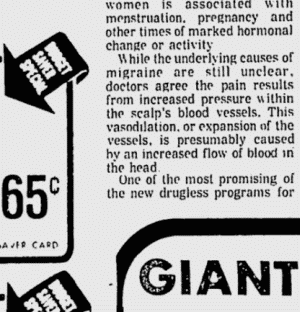Vasodilation and Migraine – The fall of a theory
Blood vessels have sometimes been described as "smart pipes". Not only does blood move through them, they are also involved directly in controlling the rate of flow. They can get bigger and smaller, processes known as vasodilation and vasoconstriction.
Once upon a time, migraine was known as a "vascular" disorder. In fact, some form of this theory has been around for 350 years.
 The Lewiston Daily Sun, May 1974 |
The idea was that the dilation of blood vessels directly led to the pain of migraine. And so, some treatments focused on constricting the blood vessels.
There were various clues that led researchers to buy into the theory. For example, ergotamine treatments also seemed to constrict the blood vessels, as it calmed the migraine attack. And, in fact, the very popular Triptan drugs were developed as vasoconstrictors! Now we believe that they work for a totally different reason.
But in recent years, the vasodilation theory has been falling apart.
First, we discovered that the migraine process was much more complex. Though vasodilation may happen, there’s much more to a migraine attack than just changes in the blood vessels.
So vasodilation is not the key element of migraine. It’s not enough to explain migraine symptoms.
Not only is this not a sufficient cause, we now know it’s not even necessary.
Migraineur advocate Teri Robert, reporting on a presentation of the American Headache Society in November, summed it up this way – Vasodilation may occur as part of the disorder, but is not required for Migraine pain. (Read Vasodilation Not Necessary for Migraine)
In other words, vasodilation may not happen at all in a migraine attack!
That doesn’t mean it doesn’t happen commonly, simply that it’s not required. It may often still be a part of the process, but it’s not they key aspect, and certainly not the cause of all migraine pain.
The report at the AHS meeting, presented by Dr. Andrew Charles, also pointed out that some drugs that cause vasodilation do not cause migraine attacks.
What does this mean for the patient?
- We can now know that information claiming migraine is a "vascular disorder" caused by vasodilation of the blood vessels is out-dated.
- We can give a lower priority to treatments that claim to stop migraine by vasoconstriction.
- We don’t need to be afraid of medication just because it may cause vasoconstriction.
- We can be glad that the medical community is being freed from this erroneous idea. This is actually opening the doors to new treatments that focus on other more foundational aspects of migraine.
Further reading: The vascular theory of migraine—a great story wrecked by the facts
